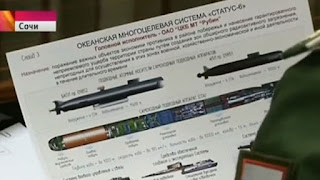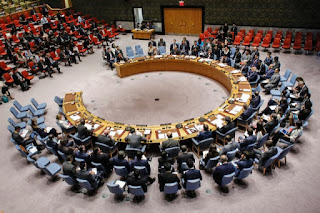Russia’s Secret New Super Weapon ‘Accidentally’ Revealed
Russia’s
Secret New Super Weapon ‘Accidentally’ Revealed
By
E. Stanley Ukeni
An interesting and noteworthy
incident occurred this week, which I think is worth blogging about. It happened
during a recent, media covered, high-level meeting between the Russian head of
state and his military chiefs.
At the gathering that took place in the
Black Sea city of Sochi, in which President Putin was meeting with senior
military officers and officials from Russia’s arms industry, a cameraman from
the Russian government-run Channel One news station, seemed to have quite by
accident aimed his camera over the shoulder of a military officer as he flipped
open a page on a ‘briefing book’.
Visible in the momentary glimpse of the
camera, one could make out dual headers that reads; “Ocean Multipurpose System
Status-6” and “Developer—Rubin Design Bureau.”
Below this are some explanatory text
and illustrations. The explanation read, in part, “Purpose—the defeat of the
important economic facilities in the area of the enemy coast,” the text reads,
“and causing unacceptable damage to… the country through the establishment of
extensive zones of radioactive contamination, unsuitable for implementation in
these areas of military, economic, business or other activity for a long time.”
The exposed renditions on the
illustrations on the revealed pages of the briefing book show the schematics
for an advanced torpedo-like Russian long-range hybrid drone mini-submarine.
Also revealed are renderings of two larger subs—the nuclear-powered “Project
09852” and “Project 09851” vessels that are under construction for the Russian
navy, and which are both reportedly optimized for rescue, reconnaissance and
other undersea special operations.
The exposed schematics indicates that
the hybrid drone mini-submarine possess a range of up to 10,000km (6,200 miles)
a depth trajectory of up to 1,000m (3,300ft). And was developed by Rubin—a
submarine design bureau in St Petersburg. It is designed to be launched by
nuclear-powered submarines of the 09852 ‘Belgorod’ and 09851 ‘Khabarovsk’
series. When launched, the weapon system travels at the speed of 100 knots
(185km/h; 115mph), which would allow the weapon to evade all acoustic tracking
devices and other decoy traps.
The description of this fearsome weapon
system strongly suggests that it could very likely be designed to equally be
deployed as a tactical aircraft carrier destroyer. This would make the ‘Status-6’
one of the most important strategic offensive weapon platforms to be fielded by the
Russian military.
In the moments before the camera was
aimed over the shoulder of the officer who was flipping open the briefing book,
President Vladimir Putin could be heard saying that the United States and its
NATO allies were proceeding with their plan to deploy a global anti-missile
defense system…“Ignoring our concerns and our offers of cooperation”.
He continued that the Western defense
project was, “an attempt to undermine the existing parity in strategic nuclear
weapons, and essentially to upset the whole system of global and regional
stability”.
President Putin further impelled the
leaders of Russia’s military industrial complex to continue developing
strategic offensive weapons systems capable of penetrating any anti-missile
defense that Russia’s adversaries would devise.
The State-sponsored Channel One news
station broadcast the footage at least once before editing the shots to remove
the revealed briefing book footage—perhaps at the instruction of incensed Kremlin
censors. However, it was too late to suppress the revelation as attentive
viewers had already posted the original clip to YouTube—and got busy
circulating the screenshots on social media. A clip of the aired footage, now
circulating online, has as sparked social media frenzy.
The spokesman for the Russian
president, Dmitry Peskov, confirmed the embarrassing incident in a public
remark, “It’s true some secret data got into the shot, therefore it was
subsequently deleted. In the future we will undoubtedly take preventive
measures so this does not happen again.”
The Russian government
newspaper, Rossiiskaya Gazeta, subsequently published details of the secret
weapon system—without the revealed schematics. In the published report, the
newspaper speculated that the exponential explosive yield of the hybrid drone mini-submarine’s warhead
would suggest it to be a Cobalt bomb.
This is a type of thermonuclear warhead grafted with a layer of
cobalt-59, which upon detonation would be transmuted into highly radioactive
cobalt-60—with a half-life longer than five years.
The newspaper report indicated that a Cobalt bomb would guarantee
the annihilation of every living thing within its radioactive blast range—and
that even bunkers would not have any survivors.
A cobalt bomb has never been tested by any country, for good reason…even
a test would unleash a devastatingly lethal radiation.
Although it is quite possible
that an editing mistake and lapse in security oversight may have unwittingly
caused the revelation of what should be a ‘top secret’ briefing document with
perfectly legible specs and schematics for a new Russian weapon system, it is
equally plausible that the mistake was not accidental. This could possibly be a
textbook case of an orchestrated effort at spreading disinformation for an
ulterior motive. The Russian are, after all, well known to be master of the art
of disinformation.
The fact is that there is no
way of definitively confirming the existence of the sort of radiological
weaponry described in the leaked briefing document. However, if the information
contained in the accidentally recorded document is real, Russia does indeed
possess such a menacing radiological weapon—then it would be the first country
known to possess such a tactical weapon.
This article is
authored and published by E. Stanley Ukeni. Copyright © 2015. All Rights
Reserved. This material and other articles or stories posted on this blog site
may not be reproduced, published, broadcast, rewritten or redistributed, in
whole or in part, without prior expressed written permission from the author,
E. Stanley Ukeni.





Comments
Post a Comment